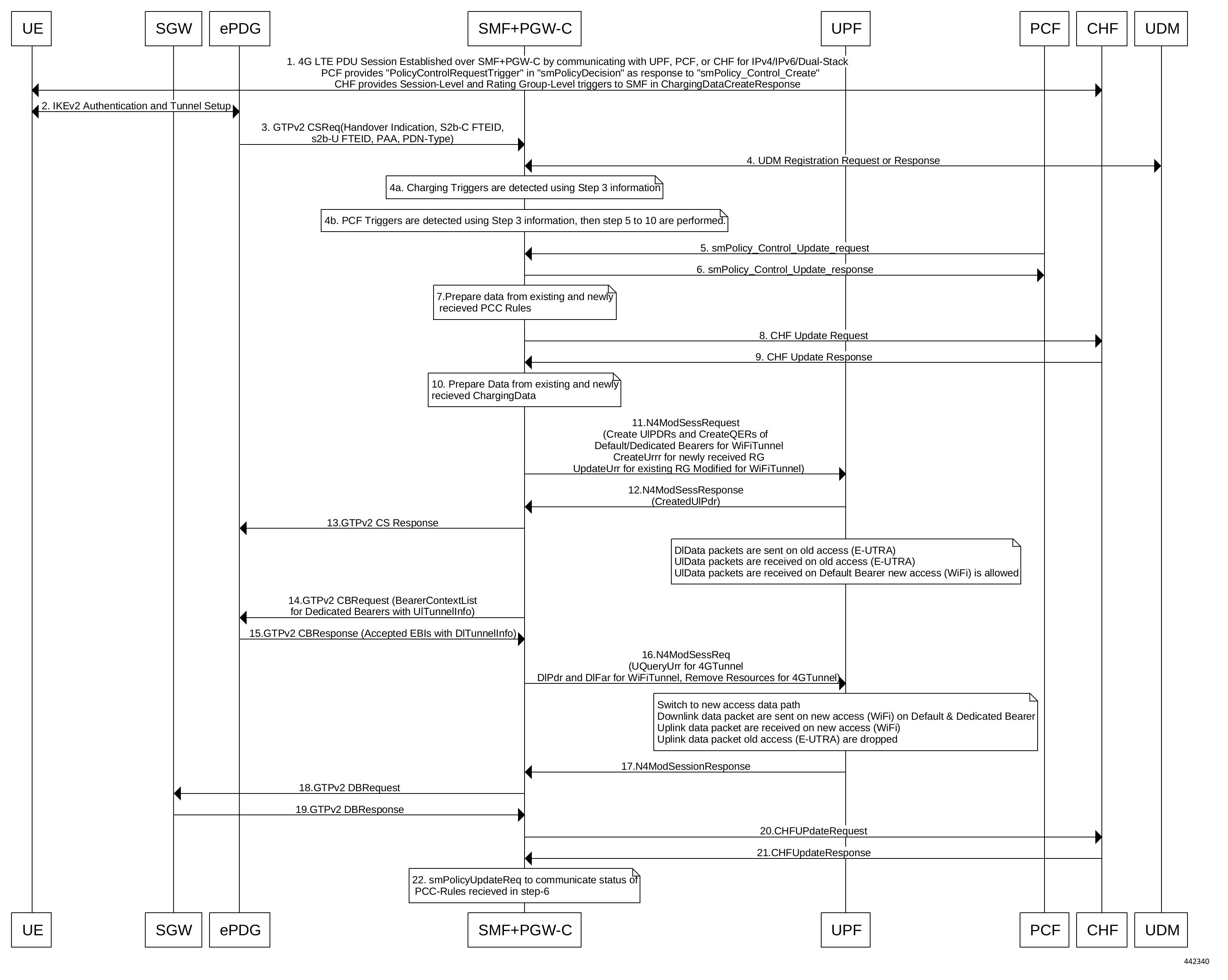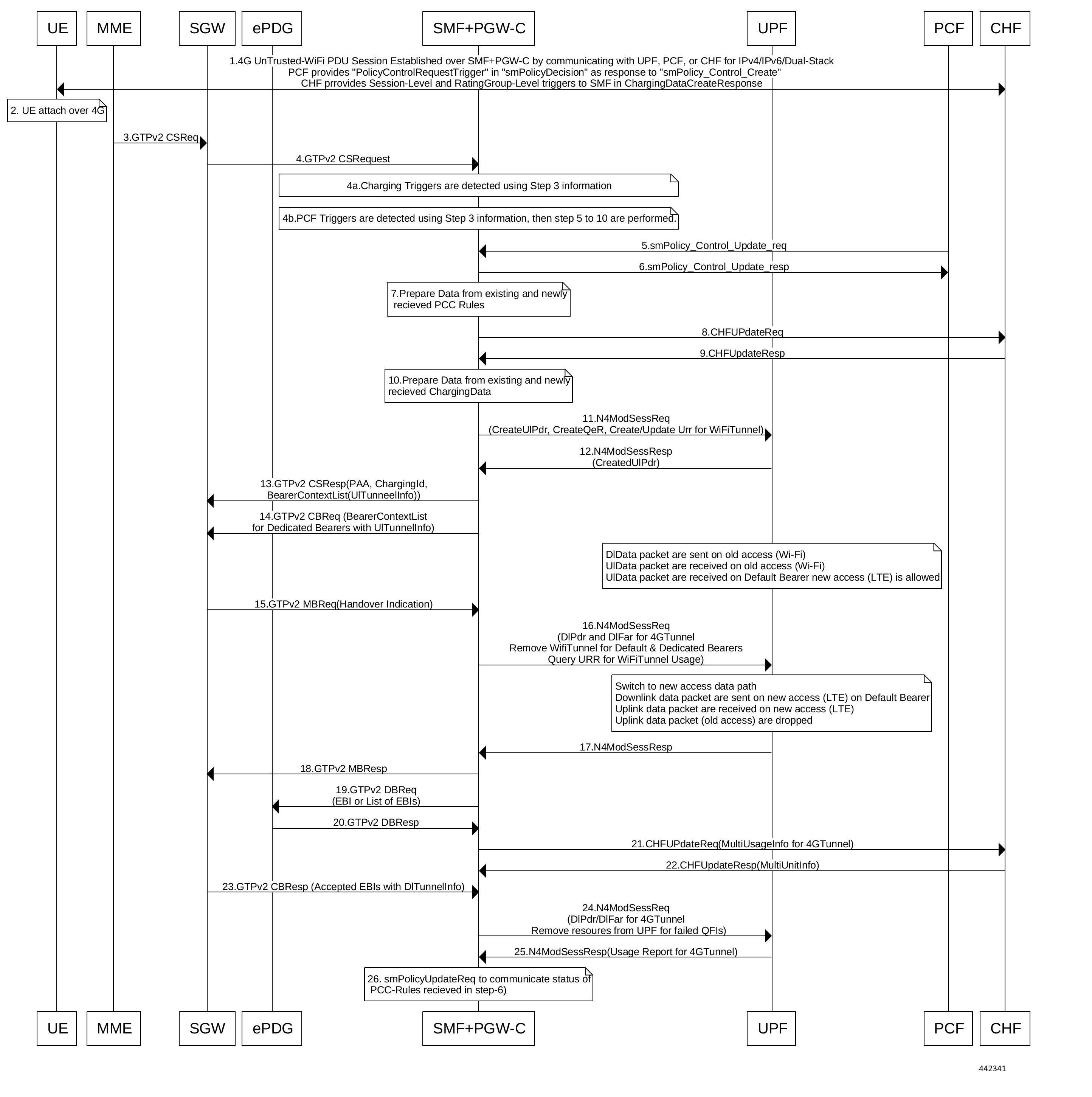| 1 |
One or more PDU sessions are established between UE and ePDG through untrusted non-3GPP access. With the 5G NAS capability
of UE, ePDG selects a combined PGW+SMF. UE sends the PDU session ID to the PGW+SMF.
|
| 2 |
UE discovers the E-UTRAN access and hands over the sessions from the currently used non-3GPP access system to E-UTRAN. For
details on UE discovery of the 3GPP access system, see 3GPP TS 23.401, section 4.8.
UE sends an Attach request to MME for the Handover Attach request type. E-UTRAN routes the messages received from UE to MME
as defined in 3GPP TS 23.401. UE includes the one of the APNs which are corresponding to the PDN connections in the source non-3GPP access. The APN is
provided as defined in 3GPP TS 23.401.
|
| 3 |
MME and HSS perform authentication, which is followed by location update procedure and subscriber data retrieval to receive
the APN information.
The MME selects an APN, an SGW and PDN gateway as defined in 3GPP TS 23.401. MME sends a Create Session Request message to SGW. This request includes information on IMSI, MME context ID, PDN-GW address,
handover indication for the “handover” request type, and APN.
|
| 4 |
SGW sends a Create Session Request, which is handover indication, message to PDN-GW in the HPLMN as described in 3GPP TS 23.401. As the MME includes the handover indication information in the Create Session Request message, the SGW sends the GTPv2 Create
Session Request message to PDN GW. This message includes details on IMSI, APN, handover indication, RAT type, S5-C TEID, S5-U
TEID of the user plane, EBI, and user location information. The RAT type indicates the 3GPP IP access E-UTRAN technology type.
If the UE supports IP address preservation and is included in PAA, the SGW configures the handover indication in the Creation
Session Request. With this configuration, the PDN GW re-allocates the same IP address or prefix that was assigned to the UE
while it was connected to the 3GPP IP access. With this configuration, SGW initiates the Policy Modification Procedure to
the PCF.
As the handover indication is includes, the PDN GW does not switch the tunnel from non-3GPP IP access to 3GPP access system
at this point.
SMF does not perform the UDM Registration as the registration happens during the Wi-Fi session establishment.
|
| 4a |
SMF detects the charging triggers with the information available in Step 3 against the charging triggers that are received
during EPC session establishment.
|
| 4b |
SMF detects the PCF triggers with the information available in Step 3 against the Request Policy Control triggers that are
received in the communication with PCF during EPC session establishment.
|
| 5 |
Based on the detected armed Policy Control Triggers that are received in Step 4b, SMF sends the SM Policy Control Update request
with the detected access parameters in Step 3 to PCF.
|
| 6 |
PCF sends the SM Policy Control Update response, which is the SM policy decision, by including new or updated PCC rules. |
| 7 |
Based on the information received in Step 6 and existing policy data of EPC session, SMF prepares the information for the
new or updated PCC rules.
|
| 8 |
If SMF receives new PCC rules in Step 6, the SMF sends the Charging Update request, with the new rating-group having quota
information, to CHF. This request includes the PDU session information with the new access params.
|
| 9 |
CHF sends the multi-unit information as Charging Update response to SMF. The multi-unit information includes new quota information
for the rating-group and the existing rating-group of EPC session, if any.
|
| 10 |
SMF prepares the charging data of the received Charging Update Response that CHF sent. |
| 11 |
SMF sends the N4 Session Modification Request to UPF. This request includes the details on creation of UL and DL PDR, creation
of QER, creation of URR for received new rating-group quota information, updated URR for modified quota information, and creation
of FAR.
|
| 12 |
UPF sends the UL tunnel information in the created PDR as N4 Session Modification response to SMF. |
| 13 |
SMF sends the GTPv2 Create Session response to S-GW. This response details on request accepted or request accepted partially,
P-GW S2b F-TEID, PAA, APN-AMBR, bearer context creation, charging gateway address, and APCO.
|
| 14 |
SGW sends the Modification Bearer request with handover indication to PGW for data path switching from Wi-Fi tunnel to 4G
tunnel.
|
| 15 |
PGW sends the N4 Session Modification request to delete the Wi-Fi tunnel and to configure DL tunnel information that is received
in GTPv2 Create Session request for 4G tunnel in Step 4.
|
| 16 |
UPF sends the N4 Session Modification response to SMF. |
| 17 |
SMF sends the GTPv2 Create Session request, which includes the bearer context list, to SGW. This list includes the DL Tunnel
information for the end-user.
|
| 18 |
SGW sends the GTPv2 Create Session response to SMF. This response includes details on request accepted or request accepted
partially and bearer contexts.
|
| 19 |
ePDG sends the GTPv2 Create Bearer resp (accepted EBIs with DL tunnel info to SMF |
| 20 |
SMF processes the Create Bearer response and derives the DL tunnel Information for the established bearer and the failed EBI
list, if any. SMF sends the N4 session modification request to UPF for Wi-Fi tunnel. This request is to update the DL FAR
with the DL tunnel information, RAT modification information, and to delete resources for the 4G tunnel. SMF also deletes
the N4 resources of Wi-Fi tunnel for the received failed EBI list or the failed QFI list.
|
| 21 |
UPF sends the N4 Session Modification Response with usage report to SMF. |
| 22 |
SMF sends the Charging Update request to CHF. This request includes the PDU session information with new access params and
multi-usage report consisting of access-params and usage report that is received in Step 8.
|
| 23 |
CHF sends the Charging Update Response with multi-unit information that contains quota information for the existing rating-groups
to SMF.
|
| 24 |
SMF+PGW-C initiates the GTPv2 DB Request toward SGW by including EBI or EBI list. |
| 25 |
SGW sends the GTPv2 DB Response toward SMF+PGW-C. |
| 26 |
SMF sends the SM Policy Control Update request to UPF. This request includes the new access params and rule report for failed
QFI list that is received from AMF as part of Create Bearer response.
PCF sends the SM policy decision as SM Policy Control Update response.
SMF processes the SM policy decision and handles it as PCF Initiation Modify procedure as defined in 3GPP 23.502 section 4.3.3.2.
|



 Feedback
Feedback